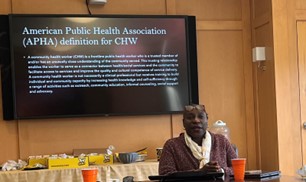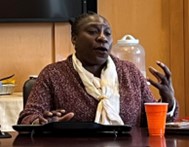Obasanjo Discusses Addressing Health Disparities with Community Health Workers
The Schroeder Center for Health Policy invited Iyabo Obasanjo, PhD, Associate Professor of Kinesiology, to speak to W&M students about the role public policy plays in addressing health disparities through the use of community health workers (CHWs). Professor Obasanjo has written extensively on the importance of these workers in providing health and social services to low-income communities. Her most recent article, “Understanding the Public Health Role, Motivations, and Perceptions of Community Health Workers Deployed to Low-Income Housing in Richmond, Virginia,” was published in Community Health Equity Research & Policy and was supported, in part, by the Schroeder Center. During her talk to the W&M community, Professor Obasanjo discussed the role of community health workers in the healthcare system generally and in the Richmond area specifically, giving insight into defining who a community health worker is, what these workers do, and why policymakers should support them.
 Professor Obasanjo explained that the American Public Health Association (APHA) defines a community health worker as a “frontline public health worker” who serves “as a connector between health/social services and the community to facilitate access to services and improve the quality and cultural competence of service delivery.” Community health workers, who are typically female, usually work with individuals who live in poverty in low-income areas or in “communities defined by poor health outcomes.” Professor Obasanjo noted that they often operate out of public housing developments as a way to efficiently help those most in need.
Professor Obasanjo explained that the American Public Health Association (APHA) defines a community health worker as a “frontline public health worker” who serves “as a connector between health/social services and the community to facilitate access to services and improve the quality and cultural competence of service delivery.” Community health workers, who are typically female, usually work with individuals who live in poverty in low-income areas or in “communities defined by poor health outcomes.” Professor Obasanjo noted that they often operate out of public housing developments as a way to efficiently help those most in need.
Community health workers were particularly essential in connecting individuals to health care services during and after COVID, Professor Obasanjo noted, and their numbers are projected to increase by 21% over the next decade. She described how community health workers help to “reduce emergency room use” and how they address “the rural health deficit” as most “social support agencies usually exist in urban areas.” Professor Obasanjo spoke, too, about how community health workers focus on the mental health of those seeing them and connect them to services as a way to help reduce their stress, which left unaddressed can lead, in some cases, to preventable health problems such as high blood pressure and heart disease.
Professor Obasanjo concluded her talk with a discussion of policies that affect the use and reimbursement of community health workers. She said that while every state has a Medicaid program to provide health coverage to low-income families, Medicaid reimbursement of community health workers’ services is available in only 20 states. The Federal Government, she mentioned, has not denied any state that has requested approval to pay for community health workers’ services. She noted, however, that Virginia is not one of the states requesting such approval, as the state wants additional data showing the effectiveness of community health workers.
reimbursement of community health workers. She said that while every state has a Medicaid program to provide health coverage to low-income families, Medicaid reimbursement of community health workers’ services is available in only 20 states. The Federal Government, she mentioned, has not denied any state that has requested approval to pay for community health workers’ services. She noted, however, that Virginia is not one of the states requesting such approval, as the state wants additional data showing the effectiveness of community health workers.
More information about Professor Obasanjo and her co-authors’ research on community health workers is available in these two articles:
- “Understanding the Public Health Role, Motivations, and Perceptions of Community Health Workers Deployed to Low-Income Housing in Richmond, Virginia” (2023) published in Community Health Equity Research & Policy
- “A Case Study of a Community Health Worker Program Located in Low-Income Housing in Richmond, Virginia” (2022) published in Community Health














